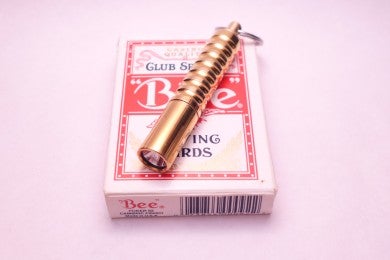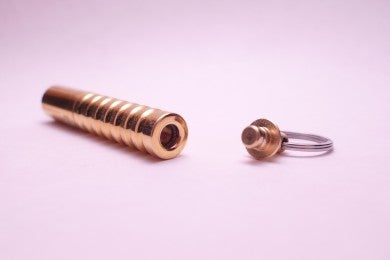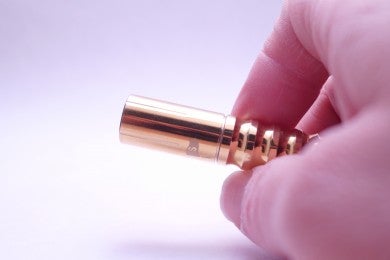Prometheus Beta QRv2 Review
Tony Sculimbrene 03.31.15

The original Beta QR light from Prometheus was a huge Kickstarter success and one hell of a 1xAAA light. The light was scheduled to fund at $12,000, and it raised over $134,000.
The light took the EDC community by storm thanks to is good price, excellent features, stellar performance, and unique look. The hook–or really in this case the unhook–for the device was the fact that it could easily be removed from your keychain. Using a quick release feature like those found on pneumatic tools, the QR could live on your keychain and then pop off in a second if you had to go search for something.
Jason Hui, the brains behind Prometheus, is someone I have dealt with for a long time. He was the first person to send me a review sample way back in 2011 when my site started, and I have reviewed a bunch of stuff for him, including his excellent pen, the Prometheus Writes Alpha, and the original Beta QR. When he sent me a “care package” that included the v2 QR I was stoked. When I discovered it was the Scout Leather collaboration version, which is polished brass. I was doubly stoked.
Description
Here is the product page. Here is my review of the original v1 light.
The Prometheus Beta QRv2 is a single cell flashlight that runs on 1xAAA. It is a production light, though Prometheus does make custom and midtech lights. It is designed primarily as an EDC light or as a light to live on your keychain.
Both the v2 and v1 versions had a quick release mechanism on the tail of the light. The upgrade to v2 focuses on that quick release mechanism. The light runs a Nichia 219 emitter for highly accurate color rendering. It has a three stage twisty (twist and twist again to change modes) interface. Low is 1 lumen (for 55 hours), medium is 15 lumens (4 hours), and high is 85 lumens (45 minutes). The light can run both alkaline and NiMH batteries. The overall size is quite small:
This makes the light fit well on a keychain or in a coin pocket on jeans. There is a clip available from Prometheus should you want to carry it that way. The review sample is gorgeous brass, but the light is available in copper, titanium, and HA III aluminum.
Testing
I carried the v2 QR for more than a month as an EDC light, both with my keys and in my pocket. I do not like keychain carry for a light, in part because even the smallest lights make my keychain huge, but the QR device here was a nice feature. It let me keep the light on my keychain when it was convenient and in pocket when it wasn’t.
The vast majority of the time, the light was used around the house–to walk the garbage out to the curb, check the roof after snowstorms (lots and lots of snowstorms), and to find dropped or lost items. I also used it to illuminate my car at night after work. These tasks were handled with ease by the Beta QR.
Design
Prometheus’s distinctive styling, the ribbed body tube, harkens back to an Art Deco feel, looking like a blaster from Flash Gordon. The Beta QR echoes his original light and his pen, and all are a welcome change of pace from HA III knurled aluminum. The UI is simple and effective, but I would prefer a staged twisty (here twisting the head in one continuous motion takes the light through its various outputs). All of these things are carried over from the original Beta QR and all are good, except the UI, which is merely okay.
The difference between v1 and v2 is the use of a canted coil spring as the quick release mechanism.
As I mentioned before, the original QR was a quick release like you’d find on pneumatic tools. It was so innovative that I didn’t mind the need for two hands and the fact it was a bit fiddly. But the canted spring design is simply light years better. It has less slop in it, wiggles less when in place, and can be activated with a simple tug. This is a great design and I’d love to see it in other gear (like a SAK’s split ring). I am not sure this alone is worth an upgrade from the original, but it is unquestionably a superior design.
Implementation
Prometheus’s fit and finish on in-house stuff, like the Prometheus Writes Alpha, is pretty extraordinary. The electroplated aluminum finish on that pen is flawless, even now, more than two years later.
The fit and finish on the original QR was good as well, and there is no difference here. Be aware that these lights are not made by Jason Hui (the man behind Prometheus), but they are built overseas (China) to his specifications. In particular the emitter was very nicely centered and the threads are smooth and clean.
The big deal, however, is the QR mechanism. Here it is positively rock solid. The pull weight, according to spec, is 10 pounds and that feels about right. The amazing thing is that until you reach that point it feels locked in, like it is a piece of the light itself instead of something attached to the light. When on a keychain the light never came off on accident, even when I got my keys wadded up in my snow pants during one particularly vicious winter storm.
In hand the light feels great. It has that magic ratio of length to diameter that makes a flashlight comfortable, and the ribbing does a good job of giving you a good grip on the light.
The brass is noticeably heavier than aluminum, and I would imagine that over time, it will acquire a great patina. I do wish the UI was a bit different, as the twist-twist again UI is fiddly, especially on a light of this size.
Conclusion
The original Beta QR was the best keychain light on the market at the time of its release. This light is better than that one, and though the competition has gotten stiffer (and will get more so soon thanks to the SureFire Titan and Titan Plus), right now this is probably the pinnacle of keychain lights.
Many years ago folks loved and raved about the Arc Light AAA-P. It was the first real, high performance keychain light and smoked the still ubiquitous Mag Solitaire. But Arc went out of business, and those AAA-P are hard to find. The Beta QR is the closest thing we have to a successor, and in brass, it is a stunning piece–as useful as it is beautiful.


